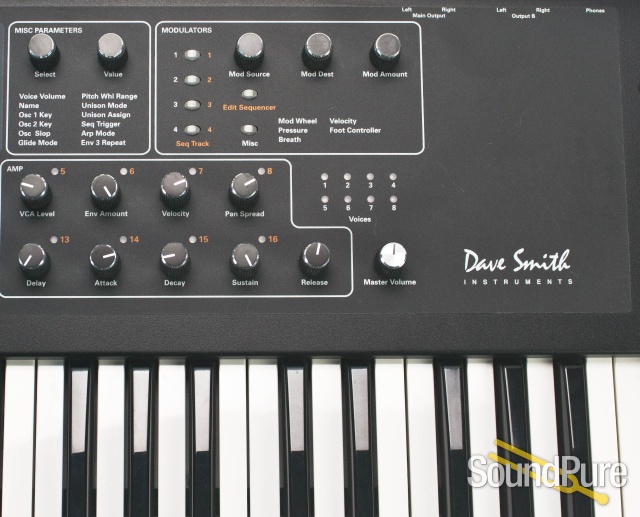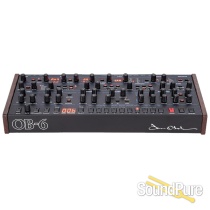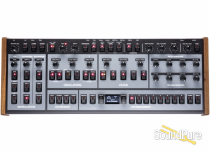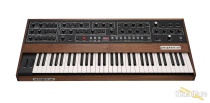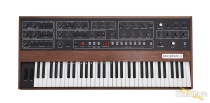-
Call Us Toll Free888-528-9703
-
Local/International (+1)919-682-5552
- Call Us! Toll Free! 888-528-9703
- Local / International (+1) 919-682-5552

Dave Smith Instruments Prophet '08 Keyboard From Sequential
Incredibly intuitive polysynth with all-analog signal path.
Manufacturer's Description from Sequential
With real analog oscillators, famed Curtis low-pass filters, and analog VCAs, the Prophet ’08 is capable of reproducing the familiar sounds of its legendary predecessors. But modern features like a greatly expanded modulation matrix and additional modulation sources—such as three envelopes and four LFOs per voice—take it way beyond vintage gear and make it a worthy and unique addition to the Prophet family tree.
Features include a gated 16 x 4 step sequencer, arpeggiator, split or stacked key modes with separate stereo outputs per layer, and rack ears for optional rack-mounting. The Prophet ’08 module can also be used as an expander to increase the polyphony of another Prophet ’08—keyboard or module—to 16 voices.
The Prophet ’08 PE (potentiometer edition) has all the features of the standard Prophet ’08, but many of the front panel’s rotary controls use potentiometers (AKA “pots”) for more “vintage-style” control. (The standard Prophet ’08 primarily uses rotary encoders.)
- Full-featured polysynth with a 100% analog signal path.
- Classic, real analog sound—including legendary Curtis analog low-pass filters—married to a modern feature set.
- Compact size, huge sound.
- Tons of knobs for direct, real-time editing and performance.
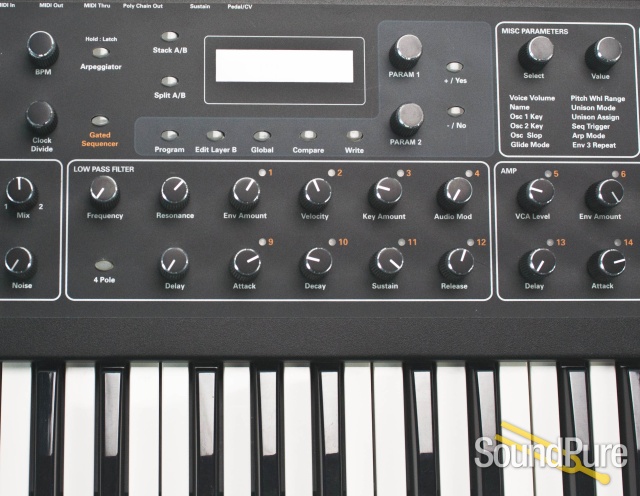
About Manufacturer
Sequential is helmed by legendary instrument designer and Grammy-winner Dave Smith, the original founder of Sequential Circuits in the mid-70s. Dave designed the Prophet-5, the world’s first fully-programmable polyphonic synth—and the first musical instrument with an embedded microprocessor.
Dave is generally known as the driving force behind the generation of the MIDI specification in 1981. It was Dave, in fact, who coined the acronym. In 1987 he was named a Fellow of the Audio Engineering Society (AES) for his continuing work in the area of music synthesis. After Sequential, Dave was President of DSD, Inc, an R&D division of Yamaha, where he worked on physical modeling synthesis and software synthesizer concepts. He then started the Korg R&D group in California, producing the Wavestation products and other technology.
He took over as President at Seer Systems and developed the first soft synth for Intel in 1994, followed by the first fully professional soft synth, Reality, released in 1997.
Realizing the limitations of software, Dave returned to hardware and started Dave Smith Instruments, which released the Evolver hybrid analog/digital synthesizer in 2002. Since then the Sequential product lineup has grown to include the Prophet X, Prophet Rev2, Prophet-6, OB-6, Pro 2, and Prophet 12 synthesizers, as well as the Tempest drum machine, co-designed with friend and fellow electronic instrument designer Roger Linn.
Dave is generally known as the driving force behind the generation of the MIDI specification in 1981. It was Dave, in fact, who coined the acronym. In 1987 he was named a Fellow of the Audio Engineering Society (AES) for his continuing work in the area of music synthesis. After Sequential, Dave was President of DSD, Inc, an R&D division of Yamaha, where he worked on physical modeling synthesis and software synthesizer concepts. He then started the Korg R&D group in California, producing the Wavestation products and other technology.
He took over as President at Seer Systems and developed the first soft synth for Intel in 1994, followed by the first fully professional soft synth, Reality, released in 1997.
Realizing the limitations of software, Dave returned to hardware and started Dave Smith Instruments which released the Evolver hybrid analog/digital synthesizer in 2002. Since then the DSI product lineup has grown to include the Prophet 12, Prophet ’08, Pro 2, Mopho, and Tetra synths, as well as the Tempest drum machine, co-designed with friend and fellow electronic instrument designer Roger Linn.
Specifications
OSCILLATORS
- 2 digitally controlled analog oscillators (DCOs) per voice with selectable sawtooth, triangle, saw/triangle mix, and pulse waves (with pulse-width modulation)
- Glide (portamento): separate rates per oscillator
- White noise generator
- Analog VCAs
- Hard sync
FILTERS
- 1 analog Curtis low-pass filter per voice, selectable 2- and 4-pole operation (self-resonating in 4-pole mode).
ENVELOPES
- 3 envelope generators: filter, VCA, and assignable (four-stage ADSR + delay); Envelope 3 can loop.
SEQUENCER
- 16 x 4 gated step sequencer
LFOS
- 4 LFO’s with key sync per LFO
MODULATION
- 4 x 2 modulation matrix with 20 mod sources and 43 mod destinations
ARPEGGIATOR
- Programmable arpeggiator with up, down, up+down, random, assign modes.
- Re-latching arpeggiation
CONTROLS
- 5-octave keyboard with semi-weighted action, velocity, and aftertouch.
- 52 knobs and 20 buttons enable deep and comprehensive editing with little to no menu diving.
- Spring-loaded pitch wheel and assignable mod wheel
MEMORY
- 256 fully editable Programs (2 banks of 128) with 2 Layers (2 separate sounds) in each Program.
IN/OUT
- MIDI In, Out, Thru, and Poly Chain
- Main stereo audio output: 1/4″ unbalanced
- Output B stereo audio output: 1/4″ unbalanced
- Sustain pedal input: accepts normally on or normally off momentary footswitch.
- Pedal/CV input: responds to expression pedals or control voltages ranging from 0 to 5 VDC (protected against higher or negative voltages).
- Headphone output: 1/4″ stereo phone jack.
POWER
- Includes power supply for 110V – 240V AC operation (13-15 VDC, 600 mA) and operation manual.
PHYSICAL SPECS
- Oiled mahogany wood end panels
- Dimensions: 12.1″ (30.73 cm) W x 34.8″ (88.39 cm) L x 3.875″ (9.84 cm) H (2.25″ at front edge; the feet account for 0.25″ of the total height)
- Weight: ~22 lbs. (9.98 kg)
